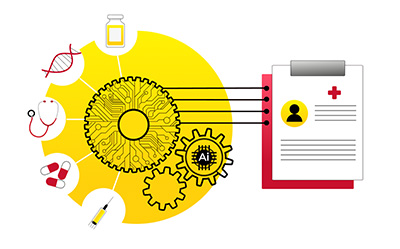What is Precision Medicine?

The Center for Translational Medicine (CTM) leads precision medicine research by developing genetic and phenotypic marker-based algorithms to personalize pharmacotherapy. Leveraging a large university hospital system and advanced predictive analytics, including AI and ML, CTM optimizes treatment outcomes by identifying biomarkers that predict individual responses to therapies.
Read on to learn about the precision medicine research the Center for Translational Medicine is engaged in.
Our Approach to Precision Medicine
The Center for Translational Medicine (CTM) adopts a comprehensive approach to precision medicine, fundamentally premised on continued personalized pharmacotherapy, by utilizing data from routine hospital visits alongside baseline information to derive treatment algorithms. This inclusive strategy ensures a more accurate and dynamic understanding of individual patient responses, continuously enhancing the precision of treatment plans.
Optimizing Digoxin Dosing in the Older Adult Population
Decision: Are current dosing and monitoring strategies for digoxin use appropriate in the older adult population?
Information: We collected EHR data from 13 UMMS hospitals in the TriNetX database for both older and younger adults receiving digoxin with associated plasma concentrations.
Analysis: Both population PK modeling and a ML-based approach will be used to 1) Identify intrinsic and extrinsic variables that explain the variability of digoxin PK in older adults 2) Assess the appropriateness of the targeted therapeutic range when monitoring digoxin in older adults and 3) Propose an optimal dosing and monitoring strategy
Identifying Placebo Responders in Binge Eating Disorder Trials Using Machine Learning
Decision: Can we reduce failure rate of pharmacological binge eating disorder trials by enriching them? We developed a strategy for trial enrichment, which allowed us to exclude placebo responders in order to improve the success of future trials.
Information: Clinical trial data from 10 studies that collected information on disease severity, comorbidities, and patient demographics was utilized to train and test our model. Analysis: We predicted the placebo response using AI/ML and utilized an explainable AI approaches to determine inclusion criteria for future BED trials.
Reevaluating Pediatric Dosing for Unfractionated Heparin with Real-World Data
Decision: Are current dosing and monitoring strategies for heparin use appropriate in the pediatric population?
Information: We collected EHR data from 633 pediatric patients at Texas Children’s hospital.
Analysis: Population PK modeling and simulation was performed to evaluate pediatric UFH infusions for achieving the anti-factor therapeutic target. We found that the UFH anti-factor Xa target is not achieved initially, especially in young pediatrics, suggesting the need to optimize UFH dosing to achieve higher therapeutic success.
Framework to prioritize drugs to be studied in pregnant population utilizing PBPK
Decisions: Is there a need for a dedicated pharmacokinetic trial for a drug in pregnant populations?
Information: We will use data from 13 UMMS hospitals to gather information on the most prescribed drugs for pregnant persons. Literature based system parameters will be used to develop and validate p-PBPK models for these drugs.
Analysis: Simulations predicting the exposure of these drugs in pregnant and non pregnant persons will be used to establish a prioritization framework for the study of medications in pregnancy in order to streamline the process of addressing the labeling gap.
Collaborators
- Center for Blood Oxygen Transport & Hemostasis (CBOTH)
- Daiichi-Sankyo
- Defense Advanced Research Projects Agency (DARPA)
- George Washington University
- Gilead
- Inova
- Johns Hopkins University
- New Amsterdam Pharma
- Otsuka
- R Adams Cowley Shock Trauma Center
- Texas Children's Hospital
- University of California, San Francisco
- University of Maryland Medical Center
- The University of Utah
- US Food and Drug Administration
Precision Medicine FAQs
How does precision medicine differ from traditional medicine?
Traditional medicine often uses a "one size fits all" approach, where disease treatment and prevention strategies are developed for the average person, with less consideration for the variations between individuals. Precision medicine looks at a multitude of individual factors including patient characteristics, disease state, genes, environment, and lifestyle differences that influence the effectiveness of therapy, allowing for more personalized and effective outcomes.
How is CTM contributing to the advancement of precision medicine?
CTM is spearheading the use of advanced pharmacometrics models and AI/ML technologies to study drug interactions, response variability, and therapeutic outcomes across different population groups. We are focused on leveraging these insights to enhance drug safety and efficacy in clinical settings, thereby advancing the field of precision medicine.
What are the applications of pharmacometrics and AI in precision medicine?
Our lab uses pharmacometrics and AI to develop personalized drug dosing regimens, predict patient responses to medications, and optimize drug development strategies. This research helps tailor treatments to individual genetic profiles, lifestyles, and health conditions, enhancing therapeutic efficacy and minimizing adverse effects.
What is the future of precision medicine?
The future of precision medicine in our lab is driven by advancing the integration of pharmacometrics and artificial intelligence to refine predictive models and therapeutic strategies. Our focus is on enhancing the personalization of drug therapies through sophisticated data analytics and AI-driven insights, which will improve efficacy and safety across diverse patient populations. This approach aims to transform patient care by delivering more precise, data-driven health care solutions.
